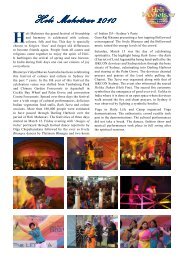Programme Brochure - Bharatiya Vidya Bhavan Australia
Programme Brochure - Bharatiya Vidya Bhavan Australia
Programme Brochure - Bharatiya Vidya Bhavan Australia
You also want an ePaper? Increase the reach of your titles
YUMPU automatically turns print PDFs into web optimized ePapers that Google loves.
History of Rath Yatra<br />
Jagannatha Puri, a town of 75,000, is one of the most<br />
important pilgrimage centers and one of the four<br />
holiest cities in India. These four cities are Badrinatha<br />
in the north, Dvaraka in the west, Ramesvaram in the<br />
south, and Puri in the east. Badrinarayan in Badrinatha<br />
was especially worshiped in Satya-yuga, Rama in<br />
Ramesvaram in Treta-yuga, Dvarakanatha in Dvaraka<br />
in Dvapara-yuga, but Lord Jagannatha in Puri can<br />
be worshiped by everyone in Kali-yuga. In fact, the<br />
importance of Jagannatha Puri, sometimes called<br />
Purushottama-Ksetra, is explained in the Uttarabhaga<br />
section of the Narada Purana. There we find it stated<br />
that simply by visiting Puri, which is rarely achieved<br />
except for those who have performed many pious acts,<br />
and by seeing the Deity of Jagannatha (Krishna), one<br />
can easily attain freedom from future births and reach<br />
the spiritual abode.<br />
In the middle of this city is the large temple dedicated<br />
to Lord Krishna as Jagannatha, meaning “Lord of the<br />
Universe.” From the Skanda Purana we get information<br />
that the original construction of the first Jagannatha<br />
temple was in Satya-yuga, millions of years ago. It is<br />
related that Lord Jagannatha told Maharaja Indradyumna<br />
that He first appeared in the Svayambhuva Manvantara<br />
of the first part of Satya-yuga, on the full moon day,<br />
after being pleased by devotion. This is about 153<br />
million years ago. Then Brahma installed the Deities in<br />
the temple. This appearance is celebrated by the Snana<br />
Purnima, or Snana-Yatra, which is the public bathing of<br />
Lord Jagannatha, His brother Balarama, and His sister<br />
Subhadra. The celebrated Ratha-Yatra festival is said<br />
to have started in the time of Svarochisha Manu, or the<br />
second Manvantara period, and is predicted to continue<br />
until the end of the second half of Lord Brahma’s<br />
lifetime. Even in the Ramayana by Valmiki Muni (Uttara<br />
Khanda) it is related that when Lord Rama was getting<br />
ready to leave this world he told Vibhishan, Ravana’s<br />
younger brother, that in His absence he should worship<br />
Lord Jagannatha, the Lord of the Iksvaku dynasty.<br />
The Skanda Purana also fixes the date of the Ratha-<br />
Yatra festival, which should be celebrated on the second<br />
day of the bright fortnight in the month of Ashadha,<br />
a day called Pushyami Nakshatra by astrological<br />
calculations. The Padma Purana describes (as related<br />
in Sanatana Goswami’s Dig Darshini Tika to his<br />
Brihad-Bhagavatamrita) that in Purushottama-kshetra,<br />
or Jagannatha Puri, the supremely blissful Personality<br />
of Godhead pretends to be made of wood. In this way,<br />
--Stephen Knapp*<br />
although the Lord takes on what appears to be a material<br />
form, it is completely spiritual by the causeless mercy of<br />
the Lord for the conditioned souls who cannot perceive<br />
the transcendental domain.<br />
The main temple building, called Sri Mandir, was built<br />
in the 12th century by King Chodaganga Deva, though<br />
the site goes back much farther as described above.<br />
This is a huge complex where buildings house as many<br />
as 5,000 priests and assistants. The whole compound<br />
is surrounded by a thick stone wall 20 feet tall that<br />
encloses an area 665 feet by 640 feet. The wall has four<br />
large gates, one on each side. The additional smaller<br />
buildings were added after the 16th century. The main<br />
temple, which reaches 215 feet in height, is where we<br />
find the six foot tall Deities of Jagannatha, Balarama,<br />
and the shorter Subhadra. They stand on a five foot<br />
high throne facing the pilgrims as they enter the temple<br />
room. Outside the main temple hall are over 100 smaller<br />
shrines dedicated to the various demigods. There is an<br />
Aarti ceremony six times a day from 4 AM to 9 PM when<br />
devotees come in for Darshan of the Deities, in which<br />
they sing, chant, or worship the Deities in ecstasy. As<br />
many as 50,000 people come to the Jagannatha temple<br />
in a day.<br />
The temple compound also has a huge kitchen, employing<br />
over 650 cooks and helpers who make hundreds of<br />
vegetarian preparations for the 54 separate offerings









